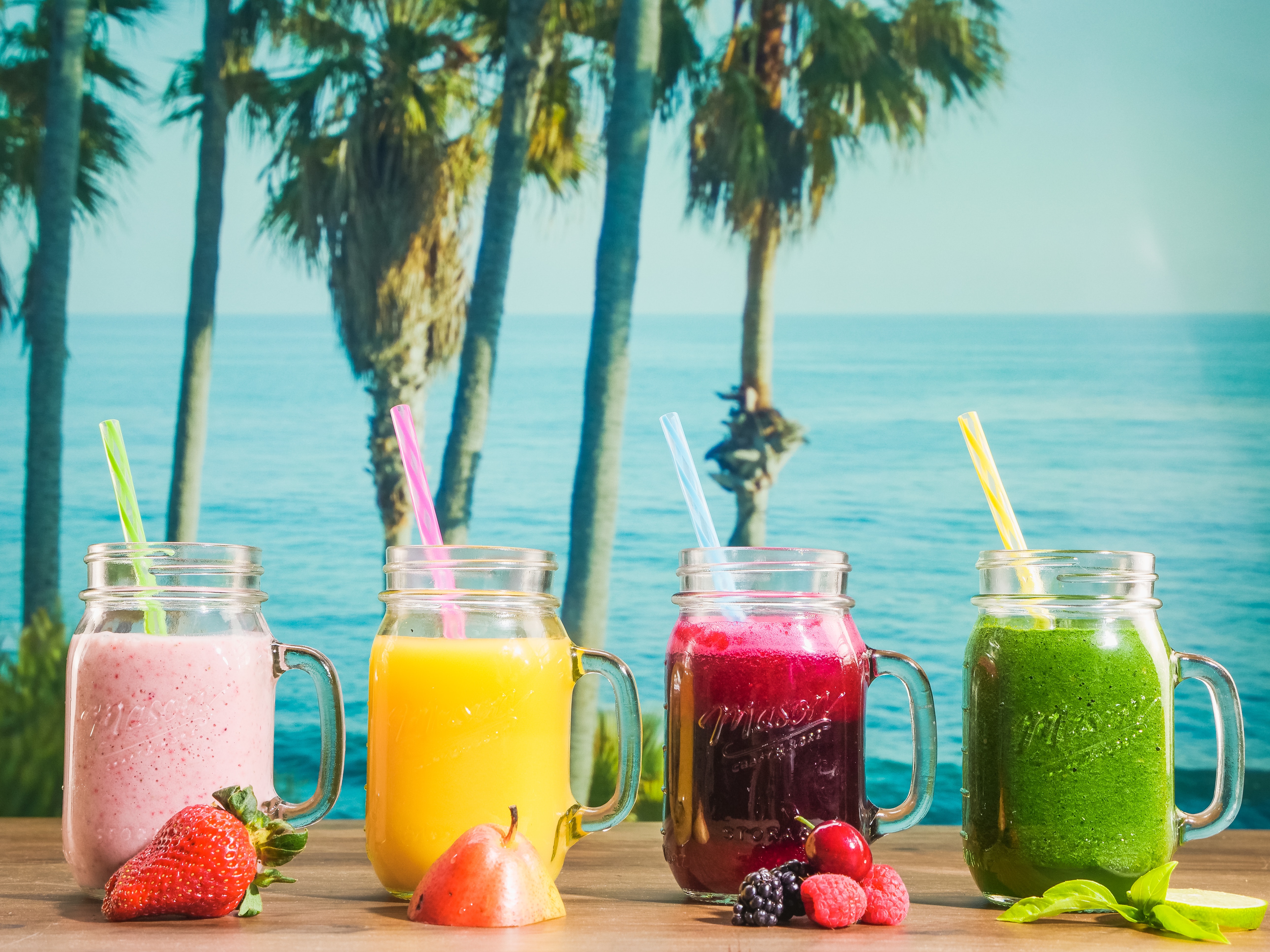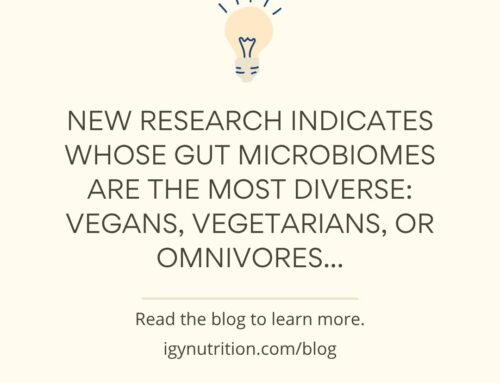Smoothies may seem like a golden ticket to gut health – but not all smoothies are created equal.
Let’s take a look at what makes a smoothie particularly gut-friendly.
Prebiotic Fiber: Fuel Your Gut Bugs
The most critical component of a gut-supporting smoothie is its prebiotic fiber content. You might be thinking, back up – what’s prebiotic fiber?
Prebiotics are “food” for probiotics – they feed the good bacteria living in the gut.
This feeding strengthens probiotics and accelerates their population growth.
Okay, they’re food for probiotics – but what exactly are they? They’re specific types of dietary fiber – nothing too fancy. You unknowingly consume prebiotics all of the time by eating certain plant foods like artichokes and apples.
Prebiotics have been shown to propel and support the growth of beneficial bacteria in the gut – precisely what we need and want for a healthy gut microbiome!
For example, prebiotic fibers increase Bifidobacteria and Lactobacilli, two of the most crucial bacteria for optimal gut health.
By increasing the count of healthy bacteria in the digestive tract, prebiotic fibers confer all benefits associated with increased beneficial bacteria, including:
● Short-chain fatty acid production
● Decreased risk of dysbiosis
● Protection against unwanted pathogens
● Inflammation reduction
● Improved digestion
● Improved nutrient absorption
● Much more!
Another bonus: prebiotics are usually cheaper and easier to get your hands on than specific strains of probiotics. That’s because you can find them in several plant foods, and they’re heat resistant (unlike many probiotics)! They do also come in supplement form if you prefer that instead.
How do I include prebiotics in a smoothie?
Many fruits, vegetables, nuts, and seeds are high in prebiotics – and make great additions to smoothies! Popular choices include:
● Bananas
● Avocado (gives a creamy flavor)
● Chia seeds
● Flax seeds
● Kiwi
● Cashews
● Pistachios
● Almonds
● Spinach (can’t taste it)
● Kale (can’t taste it)
The list goes on – incorporating prebiotics into your smoothie is easy!
For an extra kick of prebiotics, consider adding a supplement like Psyllium Husk to your smoothie. You can find these supplements near protein powders in most grocery stores.
Diversity of Plants = Diversity of Microbiome
The next step in creating a gut-supporting smoothie is including lots of plant-based ingredients to support the diversity of your gut microbiome. Why?
Scientists have shown that the best indicator of gut health is microbiome diversity. That’s because each type of bacteria in your gut benefits your body differently. So, even if you have enough good bacteria overall, increasing the diversity of that good gut bacteria will improve the scope of beneficial actions your gut bacteria can take – which is just as important!
How do you increase the diversity of your good gut bacteria? It’s pretty simple: eat lots of different kinds of plant foods!
Plant foods contain fuel for good bacteria and good bacteria themselves. Each different type of plant you consume will provide unique microbiota strains to your gut and provide your helpful gut bugs with something unique to use for fuel.
Like us, our gut microbes need a wide variety of fuels to munch on to perform their best. Ensuring you provide them with a diverse array of plant fibers – what they like to eat – will boost their strength and boost your microbiome.
The American Gut Project, a study of over 10,000 people’s microbiomes, found that no matter what diet a person ate – be it vegan, vegetarian, keto, whatever – the diversity of the food they ate was the most crucial contributor to their gut health.
The participants who ate more than 30 different plant types per week had the most diverse gut microbiomes – so when creating your smoothie, try to add as many different ingredients as possible.
For example, when creating my smoothie, I might pick three prebiotic fruits and vegetables – say, banana, avocado, and spinach – and then add as many nuts and seeds as possible.
A smoothie that includes banana, kale, spinach, psyllium husk, almond milk, cashews, chia seeds, flax seeds, peanut butter, and shredded coconut on top would count for 10 out of my 30 different plant fibers for the week!
Avoiding SAD Ingredients
Here comes everyone’s least favorite part of diet advice: what to avoid putting in your gut-supporting smoothies. SAD stands for the Standard American Diet, which is filled with highly processed foods, unnatural additives, and condensed animal fats.
There are a few ingredients/foods that harmful bacteria love to eat. By eating them, you’re just fueling their growth – the opposite of what you want when trying to overcome dysbiosis.
They might surprise you! Here they are: industrialized seed oil, processed sugar, alcohol, additives, and antibiotic-fed animal products.
You might be thinking – how would that make its way into a smoothie? Well, these ingredients, other than alcohol, often hide in plain sight!
First up is industrialized seed oil. These oils cause lots of inflammation in the gut — and we mean lots of inflammation.
Remember, reducing inflammation is necessary for healing the intestines from dysbiosis. For that reason, it’s imperative to avoid foods that cause inflammation, like these oils.
Industrialized seed oils include grapeseed oil, canola oil, vegetable oil, soybean oil, safflower oil, sunflower oil, and cottonseed oil. These often hide in nut butter and even plant-based milk! Opt for brands that do not contain these oils.
Next is processed sugar. Processed sugar is also inflammatory in the gut. Plus, it produces adverse manipulation of gut bacteria – which would work to undo your progress!
Sugar is often added to premade smoothie mixes, juices, milk, nut butter, and even some frozen fruits. Steer clear!
What’s the difference between processed sugar and sugar you can have? Stay away from white sugar, brown sugar, honey, maple syrup, and even low-calorie sweeteners other than monk fruit and stevia. Don’t worry about natural sugar in fruits.
Additives are also essential to avoid. Take a look at the ingredient list on the nutrition facts panel of your food. See anything you can’t pronounce? A good rule of thumb is avoiding those. It isn’t a perfect rule, but it usually does the job.
Emulsifiers like soy lecithin, preservatives like potassium sorbate, and other additives have been shown to impact the gut microbiome and nutrient signaling negatively. You’re better off leaving those out of your smoothie.
Again, these often hide in premade smoothie mixes, juices, milk, and nut butter. Include brands that do not contain additives.
Last up is antibiotic-fed animal products. They’re highly inflammatory, so we want to limit them as much as possible during your healing journey. Look for “antibiotic-free” on the labels.
These are commonly found in dairy products, so make sure that if you mix milk, cream, or yogurt into your smoothie, pick an antibiotic-free brand!
Probiotics: The Icing on the Cake
Last up is probiotic content. Probiotics are microbes that support gut health! Incorporating them into your smoothie will give your gut the added support it needs.
How? Fermented foods like yogurts are often the way to go. Plus, yogurt gives smoothies creaminess (yum).
Yogurt with live and active cultures (dairy or non-dairy) is exceptionally high in probiotics. Yep – you can get your probiotics by eating yogurt!
By eating yogurt, you add beneficial microbes like Bacteroidetes to your gut microbiome. Make sure the label says “live and active cultures” and keep it refrigerated. Pick unsweetened yogurts to avoid excess added sugar, which may feed harmful microbes.
Kefir is a fermented version of yogurt – meaning it typically contains a wider variety of microbes than yogurts. Kefir is chock-full of healthy, living bacteria that propel microbial diversity within our guts. Kefir is particularly helpful with the synthesis of vitamins B12 and K, too. These vitamins play vital roles in our digestion and inflammation regulation. Kefir is 99.9% lactose-free, so for those who are lactose intolerant, this makes a great alternative.
The Bottom Line
To create the perfect gut-boosting smoothie, incorporate the following:
● Prebiotic fiber
● A wide variety of plant fibers
● Probiotic sources
● No added sugar, antibiotic-fed dairy, additives, or inflammatory oils
Need help creating your first smoothie? Check out our next blog, titled “Gut-Boosting Smoothie Recipes.” Tag us in your creations @igynutrition on Instagram! Happy sipping.




